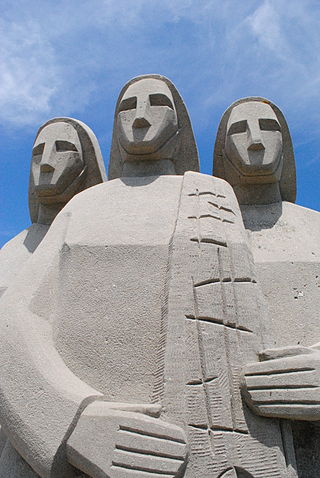A not-for-profit arts organization, also known as a nonprofit arts organization, usually takes the form of a not-for-profit organization, nonprofit organization, association, or foundation. Such organizations are formed for the purpose of developing and promoting the work of artists in various visual and performing art forms such as film, sculpture, dance, painting, multimedia, poetry, and performance art.

John Richard Chambers was an artist and filmmaker. Born in London, Ontario, Chambers' painting style shifted from surrealist-influenced to photo-realist-influenced. He used the term "Perceptual Realism" and later "perceptualism" to describe his style. He began working with film in the 1960s, completing six by 1970. Stan Brakhage proclaimed Chambers' The Hart of London as "one of the greatest films ever made."

The Jack Pine is a well-known oil painting by Canadian artist Tom Thomson. A representation of the most broadly distributed pine species in Canada, it is considered an iconic image of the country's landscape, and is one of the country's most widely recognized and reproduced artworks.
Kim Ondaatje is a Canadian painter, photographer, and documentary filmmaker.
Richard Bell is an Aboriginal Australian artist and political activist. He is one of the founders of proppaNOW, a Brisbane-based Aboriginal art collective.
Arts administration is a field in the arts sector that facilitates programming within cultural organizations. Arts administrators are responsible for facilitating the day-to-day operations of the organization as well as the long term goals by and fulfilling its vision, mission and mandate. Arts management became present in the arts and culture sector in the 1960s. Organizations include professional non-profit entities. For examples theaters, museums, symphony orchestras, concert bands, jazz organizations, opera houses, ballet companies and many smaller professional and non-professional for-profit arts-related organizations. The duties of an arts administrator can include staff management, marketing, budget management, public relations, fundraising, program development evaluation, community engagement, strategic planning, and board relations.
Canadian artist-run centres are galleries and art spaces developed by artists in Canada since the 1960s. The artist-run centre is the common term of use for artist-initiated and managed organizations in Canada. Most centres follow the not-for-profit arts organization model, do not charge admission fees, pay artists for their contributions are non-commercial and de-emphasize the selling of artwork.

Canadian art refers to the visual as well as plastic arts originating from the geographical area of contemporary Canada. Art in Canada is marked by thousands of years of habitation by Indigenous peoples followed by waves of immigration which included artists of European origins and subsequently by artists with heritage from countries all around the world. The nature of Canadian art reflects these diverse origins, as artists have taken their traditions and adapted these influences to reflect the reality of their lives in Canada.

The New Gallery (TNG) is a non-commercial artist-run centre that presents and promotes contemporary art in Calgary, Alberta, Canada.

Anthony Morse Urquhart, LL.D. was a Canadian painter. He was recognized in the late 1950s and early 1960s as one of Canada's pioneering abstractionists, having been variously linked with the Toronto painters associated with The Isaacs Gallery and The Heart of London group that included Jack Chambers, Greg Curnoe and Murray Favro.

Canadian Artists' Representation v National Gallery of Canada, 2014 SCC 42 is a landmark case of the Supreme Court of Canada on the nature of bargaining in good faith. It also has an effect on the nature of negotiations for royalties that may be due to artists under Canada's Copyright Act.
Working Artists and the Greater Economy (W.A.G.E.) is a New York-based activist group and non-profit organization whose stated advocacy mission is "to establish sustainable economic relationships between artists and the institutions that contract our labor, and to introduce mechanisms for self-regulation into the art field that collectively bring about a more equitable distribution of its economy".
Rita Keegan is an American-born artist, lecturer and archivist, based in England since the late 1970s. She is a multi-media artist whose work uses video and digital technologies. Keegan is best known for her involvement with in the UK's Black Arts Movement in the 1980s and her work documenting artists of colour in Britain.
Holly Fay is a Canadian contemporary artist in Regina, Saskatchewan. She is known for her oil paintings and drawings, which explore themes of nature, perspective, landscape, representation, and history. Her works have been exhibited across Canada and internationally. She is currently an instructor in the Visual Arts Department at the University of Regina and at the Neil Balkwill Civic Arts Centre.

Claude Roussel is a Canadian sculptor, painter and educator.
Honor Elizabeth Kever is a Canadian artist.
Constance "Colette" Joyce Urban was a Canadian/American artist known for performance art, sculpture and installation. Her work questioned social conventions, gender roles, and the relationship between spectator and performer, as well as consumer culture and the everyday with a disarming and humorous tone. Urban was a tenured Professor of Visual Arts at University of Western Ontario in London, Ontario, Canada, until 2006, when she relocated to the Bay of Islands, in Western Newfoundland and based herself in the communities of Meadows and McIvers, Newfoundland, to develop Full Tilt Creative Centre, an artist residency, organic farm and exhibition venue. In November 2012, after a lengthy period of mysterious pain, Urban was diagnosed with Stage 4 Cancer. She died at her home in McIvers in 2013.
Kelly Lycan is an installation and photo-based visual artist who lives and works in Vancouver, British Columbia.
Deirdre Logue is a Canadian video artist and arts administrator, based in Toronto, Ontario.
John Boyle is a Canadian painter known for his use of subjects drawn from his own specific life experience and from Canadian history. He was a part of the London Regional art movement. The National Gallery of Canada considers Boyle's paintings are "firmly within the realm of the Canadian response to the 1960s-era Pop phenomenon.





